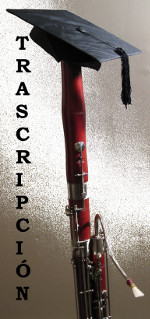Weissenborn Opus 8/2, Estudio Avanzado #10. Tocar patrones de corcheas y semicorcheas con puntillo. Discusión más a fondo de métodos de práctica saludables. Por Terry B. Ewell, Profesor Digital de Fagot. Traducido por Germán Martínez López. BDP #118. www.2reed.net
TUTORIAL
1. The tenth study by Weissenborn presents two specific
challenges due to the dotted eighth and sixteenth notes. Many students
perform the rhythm similar to a triplet rather than the correct
sixteenth.
1.El décimo estudio de Weissenborn presenta dos desafíos
específicos debido a la presencia de corcheas con puntillo y
semicorcheas. Muchos estudiantes tocan el ritmo de forma muy similar a
un tresillo, en vez de con la subdibisión a semicorcheas.
2. I recognize that historically these might have been performed as
triplets. See my article “In Search of the Borrowed Triplet
Upbeat,” The Double Reed 31/3 (2008):
95-102. However, for this study we will perform the rhythm as dotted
eighths and sixteenths. Here is the example incorrectly performed as
triplets:
2.Reconozco que, históricamente, estas notas habrán sido
tocadas como tresillos. Ved mi artículo “En busca de la
anacrusa de tresillo prestada”, The Double Reed 31/2 (2008):
95-102. Sin embargo, para este estudio tocaremos el ritmo como corcheas
con puntillo y semicorcheas. Aquí tenemos un ejemplo de
ejecución incorrecta:

Example (line 1) played with triplets
3. If you err on the side of notes shorter than a sixteenth that is
better than longer value notes. Study #36 presents similar rhythmic
issues. Here is the example correctly performed with sixteenths:
3.Si os equivocáis haciendo las semicorcheas más cortas,
es mejor que si las hacéis más largas. El estudio #36
presenta ritmos similares. Aquí está el ejemplo bien
ejecutado con semicorcheas:
Example with sixteenths
4. The second issue is that this rhythm often causes students to pulse
or accent the longer notes, the dotted eighth note. Thus the shorter
notes are less audible and in addition the smooth melodic line is
interrupted.
4.El segundo aspecto es que este ritmo a veces hace que los estudiantes
acentúen las notas más largas, la corchea con puntillo.
Como resultado, las notas más cortas se oyen menos y,
además, la continuidad de la línea melódica es
interrumpida.
Example poorly played
Example played correctly
5. There are two regions in the study that students often change the
tempo. The second measure of the second line is often rushed. Also
carefully work with the metronome in the passages with the
sixteenth-note triplets in the last two lines.
5.Hay dos lugares del estudio en el que, habitualmente, los estudiantes
cambian de tempo. En el segundo compás de la segunda
línea, los estudiantes corren. Trabajad cuidadosamente con el
metrónomo los pasajes de tresillos de semicorchea de las
últimas dos líneas.

6. I try to phrase in four bar units in the first section. In the
middle section up to the fourth line I use two bar phrases.
6.Intento frasear de cuatro en cuatro compases
en la primera sección. En la sección central, hasta la cuarta línea, hago
frases de dos compases.
Line 1, phrasing

Line 4, two measure phrases

REFLECTION/REFLEXIÓN
7.“Some simple techniques can decrease excessive
pressure on wind instrumentalists’ hands and
fingers.” (William J. Dawson, Fit as a Fiddle,
p. 43).
8. I remember as a student and a young professional my reluctance to
use a neck strap in addition to the seat strap support. I viewed it as
a sign of weakness. An injury one day to my left shoulder, however,
required me to use regularly another support for the bassoon.
Immediately I notice not only relief to my left shoulder, but also less
weight on my left hand. I could move my left fingerings better as well!
After that time I never went back to only using the seat strap.
8.Recuerdo, cuando era estudiante y joven
intérprete, mi rechazo a tocar usando un arnés junto con una correa de asiento.
Lo veía como un signo de debilidad. Un día, una lesión en mi hombro izquierdo,
sin embargo, me hizo tener que usar, regularmente, otro soporte para el fagot.
Inmediatamente noté, no solo alivio en mi hombro izquierdo, sino también menos
peso en mi mano izquierda. ¡Podía mover mis dedos mucho mejor! Después de
aquello, nunca volví a usar solamente la correa de asiento.
9.La gente alta con torsos largos acumula más peso en la mano izquierda que las personas más bajas. Aunque el arnés de cuello supuso una mejora para mí, también supuso poner peso adicional en mi cuello y músculos de la espalda. Últimamente he estado usando un arnés de cuerpo en vez de un arnés de cuello, ¡y me va muy bien! Os animo a que consideréis el uso de un arnés de cuerpo
